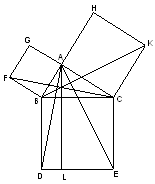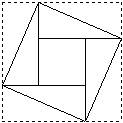如何在課堂上使用數學史?
師大數學系洪萬生教授
當同事問Kool如何在數學課堂上使用數學史時,她回答說:
Do not talk about the history of mathematics in your classroom, but do it, use it!! Use
historical problems in your teaching for reasons of variety and to give your pupils
something extra! The extras that historical problems bring to your pupils are
historical insights and mathematical insights. Historical problems may intervene at
the end of the learning process as an extra exercise or the application of a new learned
mathematical topic, or at the beginning to stimulate pupils to develop their own
individual strategies.
基於同樣的考慮,當我在很多場合 --
包括本系所『數學史』課程、短期數學教師講習班,以及針對初、高中數學教師與學生的演講
-- 討論數學史如何關聯數學 教育(HPM)時,我總是喜歡舉畢氏定理(the
Theorem of Pythagoras)的三個證法
為例,來說明數學原典(或文本)上的記載,對學生的人格薰陶、認知啟發以及(多元)文化關懷,如何可以帶來深刻的影響。
按照歷史順序,第一個方法當然必 須是古希臘歐幾里得(Euclid)【幾何原本】(The
Elements)第一冊命題47,這即 是所謂的『面積證法』,至於我選擇的 版本,則是徐光啟、利瑪竇(Matteo
Ricci) 所出版的明刊本(1607年)。第二個是古中國三國時代趙爽註解【周髀算經】時,
所提供的『弦圖證法』。第三個也是歐幾里得所貢獻,記載在【幾何原本】第六冊
命題31,由於它的證法運用了相似三角形的比例性質,因此被稱為『比例證法』。
版本,則是徐光啟、利瑪竇(Matteo
Ricci) 所出版的明刊本(1607年)。第二個是古中國三國時代趙爽註解【周髀算經】時,
所提供的『弦圖證法』。第三個也是歐幾里得所貢獻,記載在【幾何原本】第六冊
命題31,由於它的證法運用了相似三角形的比例性質,因此被稱為『比例證法』。
在簡述了這三種證法之後,我會進一步督促『閱聽人』(audience,讀者/作者)
對比(contrast)它們之間的『差異』,並一再強調數學鑑賞之所由出。試想數學一旦被認為除了可以而且必須『做』(或學著『做』)之外,原來也可以『欣賞』。
如此一來,教師與學生或有可能逐漸體會數學是某脈絡中一種知識活動(mathematics
in context),它也擁有豐富的歷史文化向度(或維度,dimension)。因此,學會了它,不僅我們的生活經驗得以強化,同時,我們的文明品味也得以提升
--
尤其,我們也可以在這樣的教學設計中,分享世紀末最令人矚目的『多元文化關懷』。
參考文獻
Furinghetti, Fulvia, "History of Mathematics, Mathematics Education, School Practice:
Case Studies in Linking Different
Domains," For the Learning of Mathematics 17, 1
(February 1997), 55-61.
Kool, M., "Dust Clouds from the Sixteenth Century," The Mathematics Gazette v.
76, n. 475 (1992), 90-96.
 版本,則是徐光啟、利瑪竇(Matteo
Ricci) 所出版的明刊本(1607年)。第二個是古中國三國時代趙爽註解【周髀算經】時,
所提供的『弦圖證法』。第三個也是歐幾里得所貢獻,記載在【幾何原本】第六冊
命題31,由於它的證法運用了相似三角形的比例性質,因此被稱為『比例證法』。
版本,則是徐光啟、利瑪竇(Matteo
Ricci) 所出版的明刊本(1607年)。第二個是古中國三國時代趙爽註解【周髀算經】時,
所提供的『弦圖證法』。第三個也是歐幾里得所貢獻,記載在【幾何原本】第六冊
命題31,由於它的證法運用了相似三角形的比例性質,因此被稱為『比例證法』。